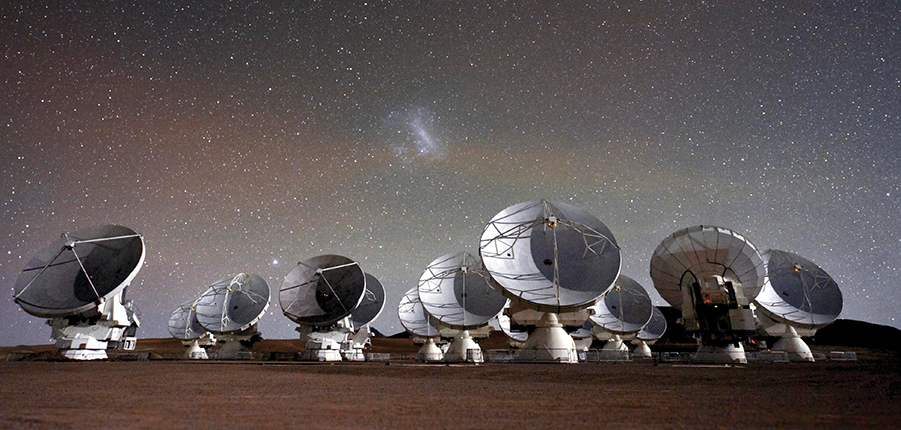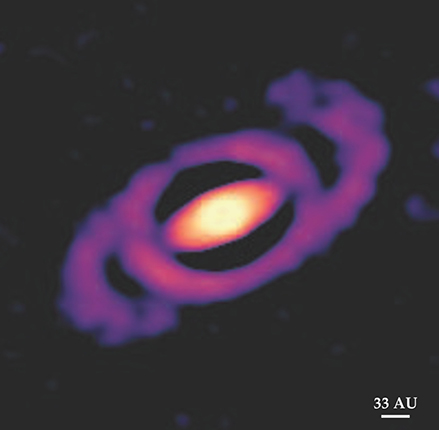Spiral arms detected around an infant star
DOI: 10.1063/PT.3.3383
Nearly five kilometers above sea level on Chile’s Chajnantor plateau, one of the driest places on Earth, the Atacama Large Millimeter/Submillimeter Array (ALMA), shown in figure 1, has a prime view of the cosmos, unhindered by light pollution, radio interference, or atmospheric scattering. So it’s little wonder that when the telescope’s state-of-the-art antennas turned their eyes toward the nascent star Elias 2-27, they picked out a detail that previous radio telescopes had missed: The star’s circumstellar disk—an unresolved blob in previous images—harbors a pair of extensive spiral arms. 1

Figure 1. The Atacama Large Millimeter/Submillimeter Array, which consists of more than 60 antennas on a desert plateau in Northern Chile, is ideally suited to detect radio-wave emissions from the dust of distant stellar systems.
C. MALIN/ESO

The observation, reported by Laura Pérez (Max Planck Institute for Radio Astronomy) and an international team of collaborators, bolsters one of the harder-to-confirm predictions of astrophysical hydrodynamics: Under certain conditions, the spinning disk of gas and dust that surrounds a gestating star will contract under the weight of its own gravity into spiral density waves. If Elias 2-27’s spiral structures are indeed manifestations of a gravitational instability, they may help resolve an age-old mystery of how infant stars survive into adulthood.
The grand design
Elias 2-27 lies in the ρ Ophiuchus cloud complex, just south of the celestial equator and a mere 450 light-years or so away from Earth. The neighborhood brims with star-forming activity. So it’s an ideal place to look for stellar systems in the early stages of planet formation.
A few years ago, Pérez found herself doing just that. Then a postdoc at the Very Large Array in New Mexico, she was part of a team that surveyed ρ Ophiuchus and other nearby star-forming regions for evidence of circumstellar disks rich in pebble-sized grains—the early precursors to planets. She and her colleagues singled out a handful of promising candidates for a closer look with ALMA.
Pérez recalls that when the ALMA results came in, “one of the disks was odd. It showed features that we had never seen.” The disk, Elias 2-27’s, contained two symmetric spirals—a configuration known as the grand design. The spiral arms, shown in figure 2, emanate from a dense ring of gas and dust about 100 AU from the host star and spread out to nearly 300 AU, about seven times the distance from Pluto to the Sun.

Figure 2. The spiral arms evident in this 1.3-mm-wavelength image of Elias 2-27’s circumstellar disk may be relics of a gravitational instability. The false-color image has been filtered to enhance contrast. (Adapted from ref.

Elias 2-27 isn’t the first star to show evidence of spiral structure in its circumstellar disk. In 2011, IR observations 2 made at the Subaru telescope on Mauna Kea in Hawaii revealed spirals around another young star, SAO 206462. A handful of studies since then have hinted at spirals in other stellar systems. In all those cases, however, the spirals were noticeably asymmetric, with one arm longer than, more massive than, or not quite 180° offset from the other. Most likely, they were the work of embedded planets massive enough to exert a gravitational drag on neighboring disk material.
The spirals surrounding Elias 2-27 seem too symmetric to have been formed by an embedded planet. Pérez thinks they were more likely formed by the gravitational pull of the disk itself.
Toomre’s spirals
The concept of self-gravity—of a body growing so massive that it’s affected by its own gravitational field—is a familiar one in astrophysics. All stars are born of the gravitational collapse of gas-rich clouds; the high temperatures and pressures generated during the collapse kick-start a chain of fusion reactions that can keep the star burning for billions of years.
A 50-year-old theory by MIT mathematician Alar Toomre suggests that some stellar systems may undergo a second gravitational collapse. As a gestating star accretes matter from its surrounding hydrogen-rich envelope, the cloud will partially flatten into a spinning disk, from which planets eventually emerge. Toomre’s math showed that in massive, moderately cool accretion disks, the destabilizing effects of self-gravity should overwhelm the stabilizing forces of thermal pressure and cause the disk to form density waves. 3 Toomre had galaxies in mind when he devised the theory, but there’s no obvious reason it shouldn’t also apply to accretion disks around stars.
If spiral density waves do form in circumstellar disks, they might help tie up some loose ends in stellar-evolution theory. Spiral waves would provide a means of siphoning angular momentum away from a star as it accretes matter. Theorists still aren’t sure how stars accomplish that task, but they know that without some way of doing it, infant stars would spin so fast as to tear themselves apart before reaching adulthood. The density waves may also be important to the planet formation process. By concentrating dust grains into relatively small regions, the arms would promote the particle collisions by which tiny grains of dust conglomerate into successively larger ones.
But spiral density waves in circumstellar disks have proven elusive, largely because it’s rare to find a disk massive enough to meet Toomre’s criteria. As a rule of thumb, only those stellar systems with disk-to-star mass ratios of 0.01 or larger are good candidates for gravitational instabilities. 4 By the time most stellar systems have matured enough to be seen through their enveloping clouds, their disk-to-star mass ratios have fallen to a fraction of that threshold.
Elias 2-27 may be an exception. Although the star is a million years old, an age at which most stars are nearing the end of the accretion phase, its disk-to-star mass ratio appears to be around 0.2. Plus, the disk is still feeding the star nearly 10−7 solar masses of fuel per year, another clue that it’s massive enough to form spiral density waves.
But the case for gravitational instability isn’t a slam dunk. When Pérez and her colleagues consider not only the disk’s mass but its temperature profile, their calculations indicate that it should be in the stable regime. Previous hydrodynamic simulations 5 by researchers at UC Berkeley and the University of Edinburgh suggest that for a star like Elias 2-27 to form the grand design observed in the ALMA study, its disk-to-star mass ratio would need to be around 0.5.
It’s possible that Pérez and company simply underestimated the disk’s mass. The 1.3 mm emission detected by ALMA shows only the distribution of the disk’s dust particles; extrapolating to get the combined mass of gas and dust involves considerable guesswork.
Still, Pérez thinks the low disk-to-mass ratio is tough to explain away. In calculating the mass of a distant circumstellar disk, one typically assumes that its dust opacity is similar to that in our solar system. For Elias 2-27’s disk to be susceptible to gravitational instabilities, she explains, “its dust opacity would need to be more than four times smaller. I think astronomers are okay with a factor of two discrepancy. But a factor of four is a bit large.”
Seeking a companion
Wladimir Lyra, a theorist at California State University, Northridge, posits another explanation for the spiral arms: Self-gravity may be working in concert with the gravitational pull of a nearby star. “If the disk has a companion, or if it passed around a star not long ago,” he explains, “the gravitational pull of that other star would raise spiraling tides in the disk. The same thing happens in galaxies.”
Pérez and company don’t see signs of stellar companions or passersby in the neighborhood of Elias 2-27, but in the dusty environment of a stellar nursery, a star—especially a brown dwarf—could, in theory, burn dimly enough to go undetected. Pérez and her coworkers will return to ALMA in the coming year to obtain higher-resolution images across a wider range of wavelengths, which may help them whittle down the possible explanations.
Meanwhile, says Lyra, the new observation is helping to reinvigorate the discussion between theorists and observers about how planetary systems come about. “That dialog was missing from the field of planet formation for a long time.”
References
1. L. M. Pérez et al., Science 353, 1519 (2016). https://doi.org/10.1126/science.aaf8296
2. T. Muto et al., Astrophys. J. Lett. 748, L22 (2012). https://doi.org/10.1088/2041-8205/748/2/L22
3. A. Toomre, Astrophys. J. 139, 1217 (1964). https://doi.org/10.1086/147861
4. K. Kratter, G. Lodato, Annu. Rev. Astron. Astrophys. 54, 271 (2016). https://doi.org/10.1146/annurev-astro-081915-023307
5. R. Dong et al., Astrophys. J. Lett. 812, L32 (2015). https://doi.org/10.1088/2041-8205/812/2/L32
